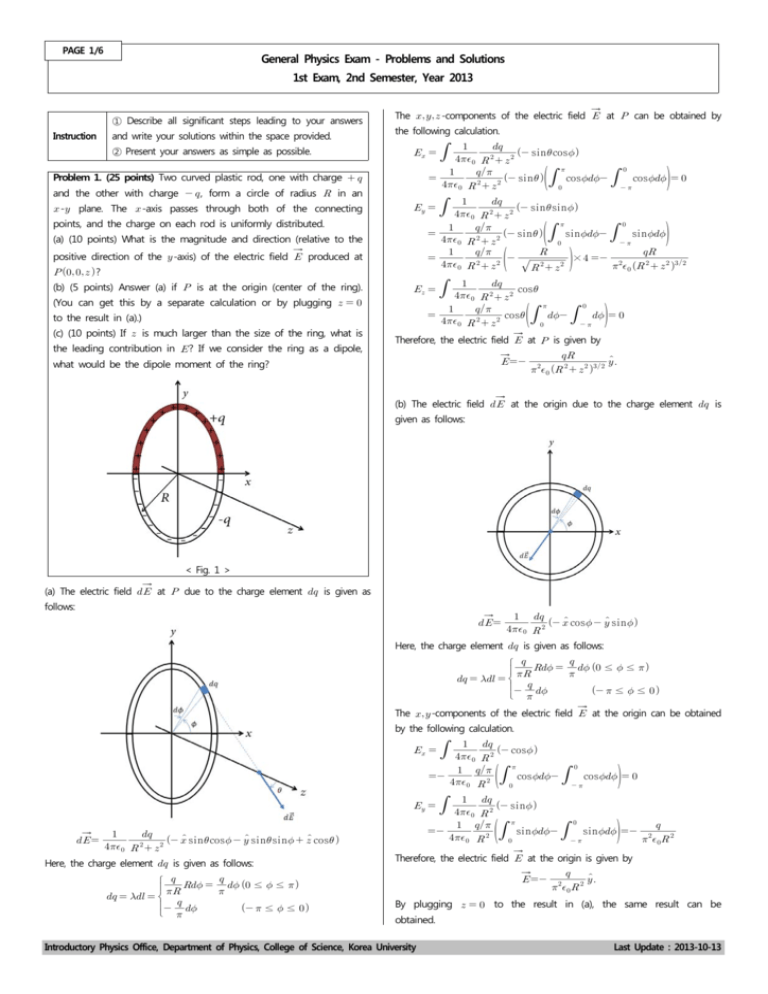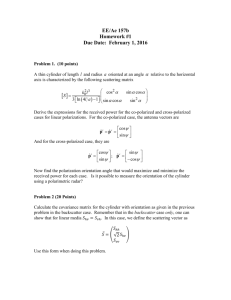Page 1 General Physics Exam - Problems and Solutions 1st Exam
advertisement

PAGE 1/6 General Physics Exam - Problems and Solutions 1st Exam, 2nd Semester, Year 2013 ① Describe all significant steps leading to your answers Instruction and write your solutions within the space provided. ② Present your answers as simple as possible. The -components of the electric field at can be obtained by the following calculation. sincos sin cos cos sin × ? cos cos to the result in (a).) the leading contribution in ? If we consider the ring as a dipole, (a) (10 points) What is the magnitude and direction (relative to the positive direction of the -axis) of the electric field produced at (c) (10 points) If is much larger than the size of the ring, what is sinsin sin sin points, and the charge on each rod is uniformly distributed. (You can get this by a separate calculation or by plugging and the other with charge , form a circle of radius in an (b) (5 points) Answer (a) if is at the origin (center of the ring). Problem 1. (25 points) Two curved plastic rod, one with charge - plane. The -axis passes through both of the connecting Therefore, the electric field at is given by what would be the dipole moment of the ring? . (b) The electric field at the origin due to the charge element is given as follows: < Fig. 1 > (a) The electric field at due to the charge element is given as follows: cos sin Here, the charge element is given as follows: ≤ ≤ ≤ ≤ The -components of the electric field at the origin can be obtained by the following calculation. cos cos sin sin sincos sinsin cos Here, the charge element is given as follows: ≤ ≤ ≤ ≤ cos sin Therefore, the electric field at the origin is given by . By plugging to the result in (a), the same result can be obtained. Introductory Physics Office, Department of Physics, College of Science, Korea University Last Update : 2013-10-13 PAGE 2/6 General Physics Exam - Problems and Solutions 1st Exam, 2nd Semester, Year 2013 (c) If ≫ and ≪ , then the electric field at can be rewritten as follows: Problem 2. (25 points) (a) (5 points) What is the equivalent resistance of this circuit? ⋯ Therefore, the leading contribution in the electric field due to the ring is given by . Consider the dipole consisting of and located at and , respectively. The electric field at can be obtained by < Fig. 2-1 > the following calculation. (b) (10 points) What is the equivalent resistance of this circuit? < Fig. 2-2 > (c) (10 points) The tip of a wire has the shape of a truncated cone, which has the resistivity of . The length of the tip is , and its larger and smaller diameters are and , respectively. What is the sin resistance of the tip? Here, corresponds to the dipole moment. Note that the dipole moment has the direction from to . If ≫ and ≪ , then the electric field at can be rewritten as follows: ⋯ < Fig. 2-3 > (a) This circuit can be redrawn as follows: Therefore, the leading contribution in the electric field due to the dipole is given by If and are compared, the dipole moment of the ring is given as follows: , , , , , , , , , or Since , is obtained. Introductory Physics Office, Department of Physics, College of Science, Korea University Last Update : 2013-10-13 PAGE 3/6 General Physics Exam - Problems and Solutions 1st Exam, 2nd Semester, Year 2013 (b) This circuit can be redrawn as follows: Problem 3-A. (25 points) There is a long insulating cylinder of radius whose symmetric axis is parallel to the -axis and goes through the origin. The cylinder has a volume charge density of . A long conducting cylindrical shell extending radially from to surrounds the insulating cylinder. The shell has no net charge. (a) (5 points) Find the charge distribution of the shell. (b) (10 points) Find the electric field and plot it as a function of , distance to the symmetric axis. (c) (10 points) Find the electric potential and plot it as a function of r. Set the potential at origin to be zero. (c) The resistance of the volume element with radius and length is given as follows: < Fig. 3-1 > (a) Since there is no electric field inside the conducting cylindrical shell, the charge distributed on the inner surface of the shell has the equal amount but opposite sign, compared to the charge distributed over the insulating cylinder. If the surface charge density on the inner surface of the shell is and the length of the system is , is given as follows: , Since the shell has no net charge, the charge distributed on the outer surface of the shell has the equal amount but opposite sign, compared to the charge distributed on the inner surface of the shell. If the surface Therefore, the resistance of the tip is given as follows: ⋅ , charge density on the outer surface of the shell is and the length of the system is , is given as follows: ⋅ ⋅ , (b) The electric field can be obtained by the following calculation. (i) : , ⋅ , ⋅ (ii) : ⋅ , ⋅ (iii) : ⋅ , (iv) : ⋅ ⋅ ⋅ , Introductory Physics Office, Department of Physics, College of Science, Korea University Last Update : 2013-10-13 PAGE 4/6 General Physics Exam - Problems and Solutions 1st Exam, 2nd Semester, Year 2013 Problem 3-B. (25 points) Two infinitely-long uniformly-charged wires are parallel to the -axis. A wire ( ) with line charge density of goes through and the other ( ) with goes through . Consider a point which is from and from . (a) (10 points) Show that has the same electric potential if is constant. (b) (10 points) Show that the points having the same electric potential form a circular cylinder extending parallel to the -axis. (c) (5 points) Draw several equipotential lines in the - plane qualitatively. Be sure to depict the case of (b). (c) Since the electric potential at origin is set to , the potential ⋅ can be obtained by the following calculation. (i) : ln ln (ii) : ln ln (iii) : (iv) : line charge density is given as follows: , ⋅ , ⋅ ln ln ln (a) The electric field and electric potential at due to with < Fig. 3-2 > , ln ( : constant) Similarly, the electric field and electric potential at due to with line charge density is give as follows: , ln ( : constant) Therefore, the electric potential at due to both and is given as follows: ln This result shows that has the same electric potential if is constant. (b) If is constant, the above result can be rewritten as follows: exp ( : constant) Since and go through and respectively, the following result can be obtained in the case of . , , , Introductory Physics Office, Department of Physics, College of Science, Korea University Last Update : 2013-10-13 PAGE 5/6 General Physics Exam - Problems and Solutions 1st Exam, 2nd Semester, Year 2013 , (i) If and , then Problem 4. (25 points) There is a long cylindrical capacitor. The radius of the inner cylinder is and that of the outer cylinder is . The so that plane forms an equipotential plane. and radii (ii) If ≠ , then circular cylinders with centers form equipotential planes. (c) Equipotential lines in the - plane have properties such that the center runs away from or and the radius increases as →. length of the whole cylinder is . (a) (5 points) What is the capacitance of the capacitor? Now we insert a dielectric material (dielectric constant : ) in two different configurations: in one configuration ( ), the inserted dielectric has a shape of cylindrical shell of two radii ( and ) and length and in the other configuration ( ), the dielectric has a shape of cylindrical shell of two radii ( and ) and length . (b) (10 points) Find the capacitance of those capacitors ( and ). (c) (10 points) When the potential difference is for both capacitors, how much work has to be done to take out the dielectric shells? < Fig. 4 > (a) Let us assume that and with charge per unit length are uniformly distributed on the inner and outer surface of cylindrical capacitor, respectively. The electric field inside the cylindrical capacitor with inner radius , outer radius , and length is given as follows: : ⋅ , ⋅ , The potential difference inside the cylindrical capacitor is given as follows: ⋅ ln Therefore, the capacitance of the cylindrical capacitor is given as follows: ln ln If and , then . ln ln Introductory Physics Office, Department of Physics, College of Science, Korea University Last Update : 2013-10-13 PAGE 6/6 General Physics Exam - Problems and Solutions 1st Exam, 2nd Semester, Year 2013 (b) In the first configuration, a capacitor with two radii ( and ) , , ln ln and length inserted a dielectric is connected to a capacitor with two radii ( and ) and length in series. Therefore, the ln calculation. ln ln ln ln ln capacitance of the first configuration can be obtained by the following , , ln (c) In the first configuration, the work done to take out a dielectric is given as follows: ln , ln ln In the second configuration, a capacitor with two radii ( and ) In the second configuration, the work done to take out a dielectric is and length inserted a dielectric is connected a capacitor with two radii given as follows: ( and ) and length in parallel. Therefore, the capacitance of the second configuration can be obtained by the following calculation. Introductory Physics Office, Department of Physics, College of Science, Korea University ln Last Update : 2013-10-13







